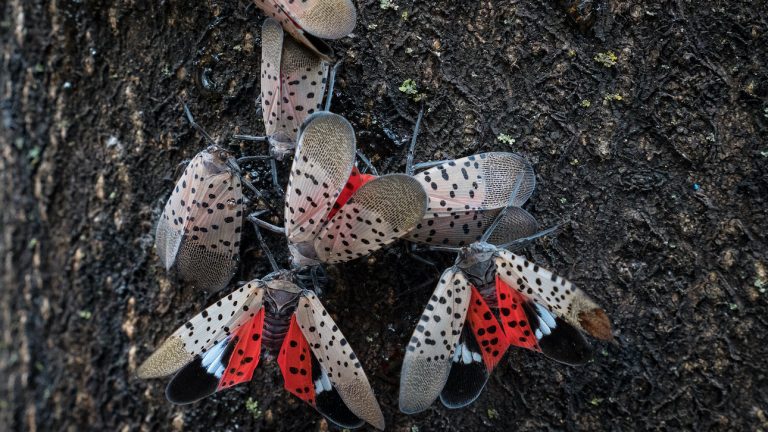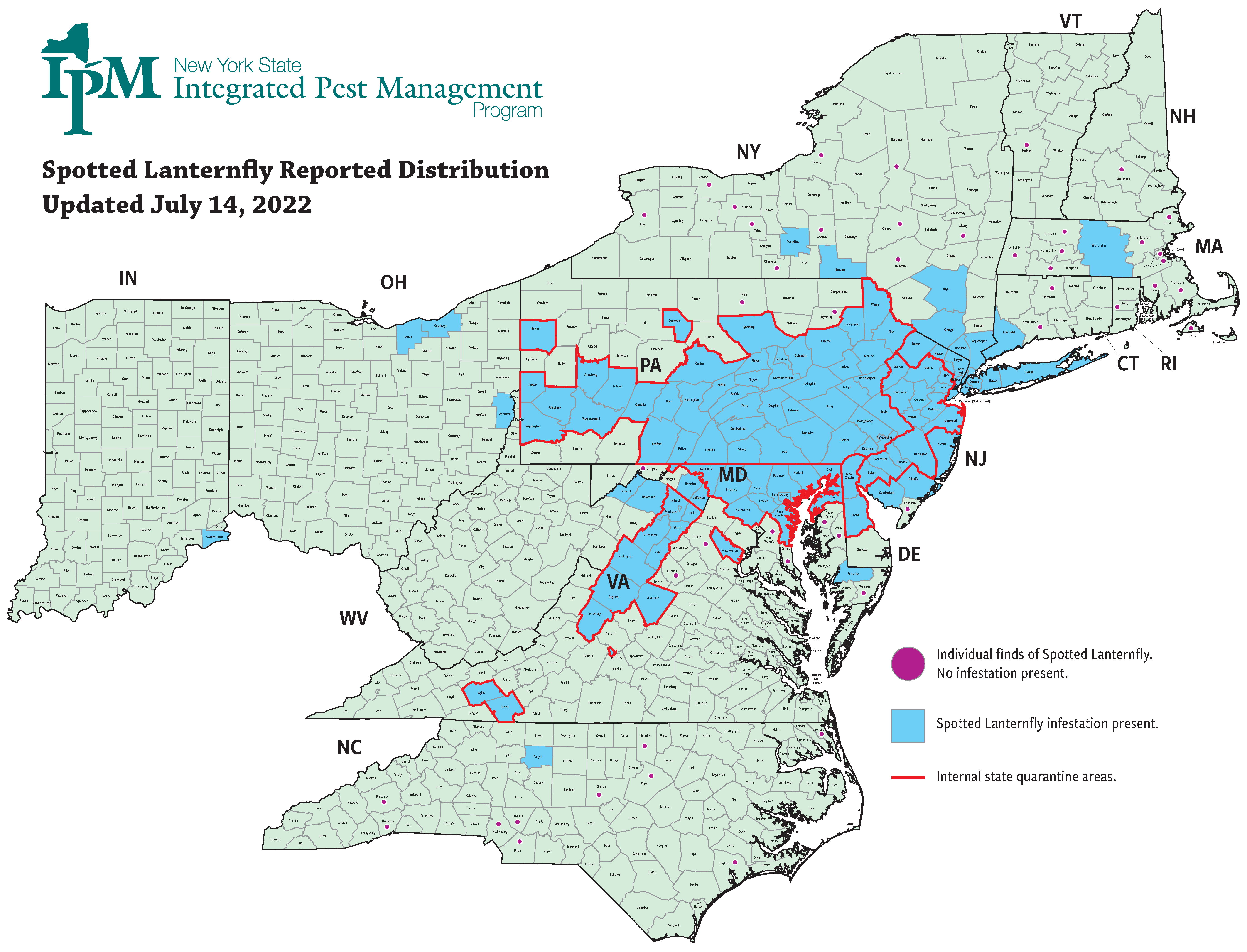
About the insect
- Invasive insect native to eastern Asia
- Excellent hitch-hiker and jumper
- Feeds on grape vines, fruit trees and 70 other tree and plant species
- Primary host is Tree-of-Heaven (Ailanthus).
Where to look
- Tree bark and branches
- The ground under host plants
- Landscaping stone
- Vehicles
- Pallets, sheds, grills and other outdoor items.
How to help
- Educate yourself and your friends
- If you see them, stomp them
- Scrape and crush egg masses
- Inspect your vehicle and remove
- Insects before travelling, particularly
- If travelling to a non-quarantined area
Background
The Spotted Lanternfly (SLF) is an invasive, non-native pest that recently arrived in the United States. It was first identified in Pennsylvania, in 2014. It has since been sighted in 15 states including New Jersey.
Life Stages

Eggs
October – May
Nymphs
May – August
Adults
July – November
Impacts
The Spotted Lanternfly is known to feed on 70 different species of trees, shrubs and vines. They are especially destructive to grape vines and fruit crops. They also secrete a sticky “honeydew” that can foul patios, outdoor furniture and other surfaces.
Advice for Control
UPDATE/ALERT: Never use glue traps on spotted lanternflies. Glue traps are catching and killing birds. Remove any glue traps on your property immediately. Follow the guidance for killing spotted lanternflies at ucnj.org/slf.
In order to avoid unintended harm to birds, honey bees, butterflies and other backyard wildlife, the following options are recommended:
Reducing their habitat: the Ailanthus (Tree-of-Heaven) tree is the primary host for the Spotted Lanternfly. It should be removed from all properties. The Ailanthus is an invasive, non-native tree. Removing it will inhibit the Spotted Lanternfly and enable more beneficial native trees to grow, too.
Sprouts can be pulled up from the roots. Consult a professional landscape or tree service for guidance on treating and removing larger trees.
Stomping or crushing them on sight.
Spraying: Use an insecticidal soap, available at your local garden supply store. Home-made sprays of liquid dish detergent and water (minimum 10 tablespoons of detergent to 1 gallon of water) can also be used, but are not as effective
Trapping: A variety of traps can be used without endangering birds. The trap should be monitored to ensure that beneficial insects are not harmed. Following are some examples:
- Set out a bowl of pine-scented cleanser mixed with two teaspoons of sugar. The Lanternflies will be attracted by the scent and drown in the bowl.
- Try a circle trap. These are commonly used for pecan weevils and are available online. Step by step instructions for home-made versions can also be found online, for example at extension.psu.edu. Video instructions are also available at extension.psu.edu/spotted-lanternfly-circle-trap.
- An empty, clear plastic, water bottle: Simply hold the bottle upside-down above the Lanternfly. It will instinctively jump up and in. Replace the cap quickly (a YouTube video made by Temple University explains how).
Scraping: The Spotted Lanternfly lays egg masses in the fall, on many different kinds of outdoor surfaces. They look like flat, textured grayish patches. They can be difficult to see on tree trunks, but are easily identified on vehicles, patio furniture and other surfaces. Inspect your property from fall through early spring for the egg masses. Scrape them off and crush them.
For additional guidance on trapping and ailanthus tree removal click here.
Quarantine
New Jersey and several other states are under quarantine rules designed to prevent the Spotted Lanternfly from spreading to other states.
Before traveling with any outdoor items from your property – including vehicles — inspect them carefully for signs of the egg masses (fall to spring), nymphs (spring to early summer) or adults (midsummer to fall).
Carefully inspect outdoor items purchased or obtained in a quarantined area, especially firewood, nursery stock and Christmas trees.
Efforts in Union County
Common pesticides cannot be used on a wide scale without harm to wildlife. In particular, the impacts of pesticide treatment would be catastrophic in Union County parks and other conservation areas.
Over the last year, the Union County Department of Parks and Recreation has been working with the US Department of Agriculture and the Rutgers New Jersey Agricultural Experiment Station to assess various methods for locating and trapping lanternflies and preventing egg masses from hatching. Circle traps were set up in the Watchung Reservation, and they have already caught thousands of spotted lanternflies.
Union County has also assembled staff from the Department of Parks & Recreation, the Bureau of Shade Tree & Conservation, the Bureau of Mosquito Control, the Bureau of Geographic Information Systems and the Rutgers Cooperative Extension of Union County to focus on fighting the infestation.
In support of this effort, Union County has received a grant from the New Jersey Department of Agriculture.
Property owners, property managers and tenants are encouraged to take the measures listed above in order to prevent Spotted Lanternfly infestations on their property.
Additional Resources
The Spotted Lanternfly belongs to a group of insects called “planthoppers.” They do not bite or sting, and they do not seem toxic to humans or pets.
Eliminating egg masses is particularly effective. The egg masses appear as small, textured gray patches on trees and other outdoor surfaces, including outdoor furniture, grills, sheds and vehicles, from November to April. They can be scraped off and crushed manually.
The eggs hatch into small, beetle-like nymphs in the spring, easily identified by bright red and black bodies with white speckles. They tend to cluster on stems and branches, and can be crushed before they hop away.
The adults emerge by midsummer and are often found resting on the ground and other flat surfaces, where they are easy to stomp. They may hop away, but they will tire and rest again after one or two hops.
The following websites are helpful:
Reported Distribution

